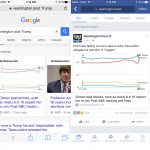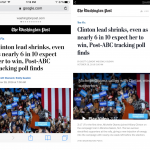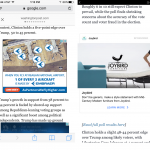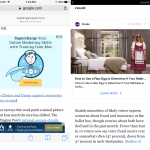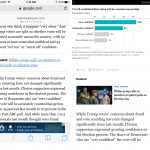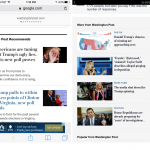Google AMP Pages VS Facebook Instant Articles – Oozle Update
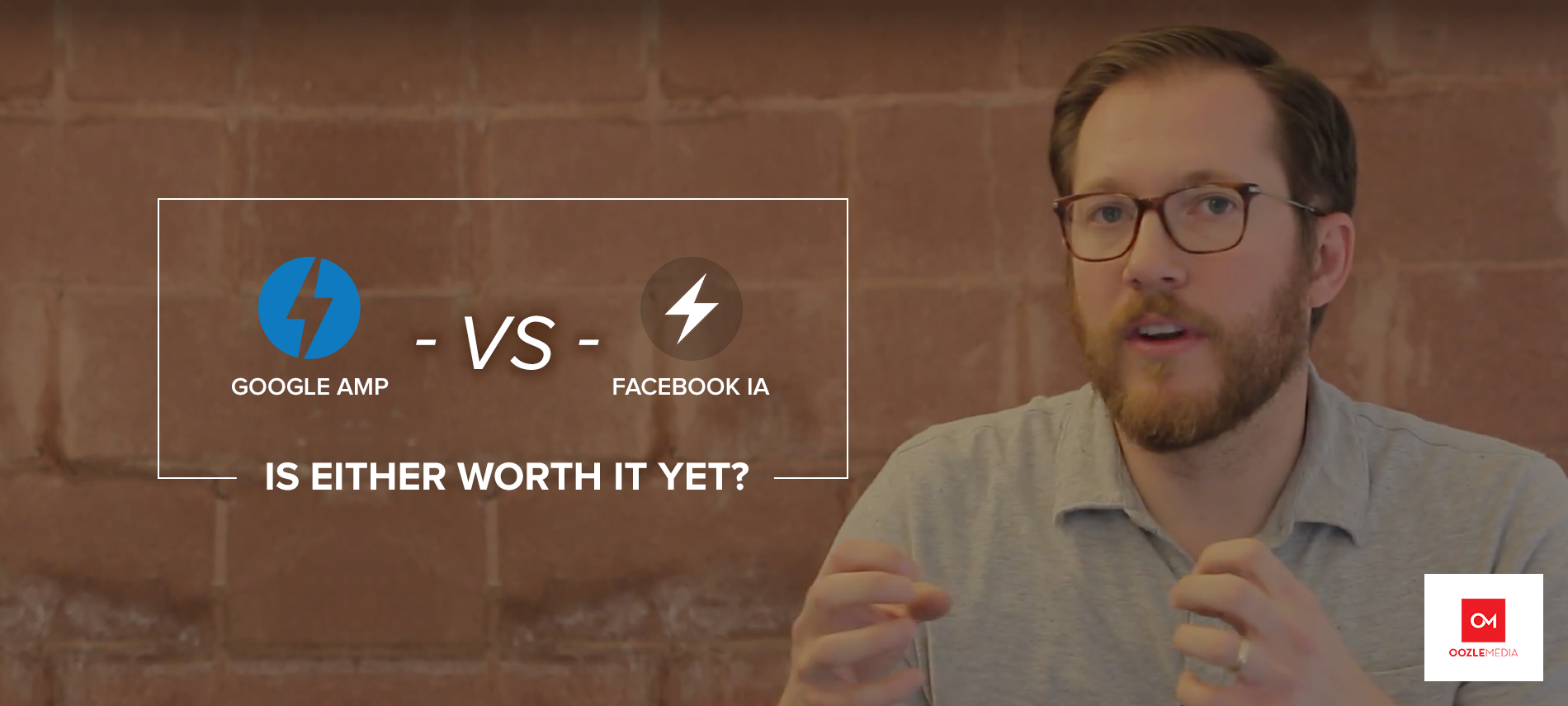
Facebook and Google are at it again. The 2 giants once again find themselves racing to solve a problem from 2 different angles (and with 2 slightly different, slightly selfish motivations). This time it’s the way we consume content, specifically on mobile devices. Today we’re going to talk about Google’s Accelerated Mobile Pages (AMP) and Facebook’s Instant Articles (FBIA), and why both exist.
Who is this Update For?
This update is for anyone who depends on mobile traffic to their site for revenue. These for-profit website owners can be grouped into 2 main camps, publishers and marketers. Publishers make money when people see their content and click on an ad. Marketers make money when a visitor becomes a sale opportunity. If you’re one of these people, you probably feel a very strong temptation to put up intrusive ads, forms, opt-ins and calls to action that hamper the mobile experience. Which brings us to our the problem Google and Facebook are grappling with.
We’ve Got A Problem
There is a problem on the internet, as more and more internet traffic comes from mobile devices, user experience is getting worse. Or better said it’s wildly inconsistent from site to site. A combination of slow servers, pop-ups, calls to actions, gated content, ads and out of date website code mean that a lot of websites have a bad experience for users on mobile.
Google has been preaching about mobile experience for years and even tries to favor “mobile friendly” results. That process still has a few kinks and bad mobile sites sneak through. Now Facebook is following suit warning that unless slow sites speed things up, they will risk decreased exposure in the feed or with ads. You might ask, “Why would Google (or Facebook for that matter) care so much about someone else’s website?” Put briefly, it’s about revenue. We as users are constantly re-assessing the value of the websites we use. In turn we adjust our behavior towards that site. If a site like Google or Facebook is consistently sending us to bad mobile websites when we click on links, we alter our behavior to use them less. This means we’ll see their ads less, and they make less money.
This is the challenge that both Facebook’s Instant Articles and Google’s Amp pages want to solve. The goal of both is to provide a ultra fast, low data, consistent mobile website experience. To do so, they require that you simplify. Both solutions opt to take the content off your site, host it themselves. While doing so, they limit the code to strip out any intrusive or data heavy elements like, intrusive CTAs, large photos subscriber opt ins, some ads and outdated or inefficient code. They think they can do a better job of making your content accessible on mobile. Think of them as you annoying friend when you’re playing a video game. “Hey give me the controller, I can totally beat this part”. Google and Facebook are probably right, the average loading time of a current mobile page is 19 seconds, compared to the 2-3 second load time (or much less) of AMP and FBIA.
How Similar Are They? Very Similar.
Before we go any further take a timeout and watch Google and Facebook say basically the same thing with different words. In fact, if you really want a trip, play them at the same time and just let the buzzwords wash over you. You will have a hard time distinguishing which words belong with which video.
The virtually identical goals of the 2 platforms give way to a similar look. In fact, I had a hard time separating the two when organizing the screenshots into the gallery. Below, the basic takeaway is they have mostly the same feature as each other. Facebook has slightly more integrated features like “popular in [My Location]”, and integrated FB display ads and platform specific CTAs.
- Pre-Click in Search
- Post Click – Header
- Inline Ads
- Inline Ads
- Inline Related CTA
- Related – end of the article
Aren’t These Platforms Old News?
Yes, we’ve been hearing about Instant Articles from Facebook and AMP pages from Google for a while now, but adoption has been slow going and in general it was thought of as a publisher problem. A few recent updates by Facebook and Google have shifted some attention back on these platforms as a viable tactic.
Facebook Sharing the Wealth
Facebook Instant Articles were initially a disaster for a publisher’s bottom line. As mentioned above, publishers were heavily restricted when placing their own ads to instant articles. So wisely, Facebook has started sweetening the deal for publishers. They now allow publishers to place ads in the instant articles using the hyper-targeting capabilities of their audience network and splitting the revenue. Additionally they have improved and re-structured rules for publications to sell their own ads. And they actively encourage what Facebook calls “branded content” sponsored by others. According to reports, at least some of the publishers are seeing the revenues return.
Google Turning Up the AMP
Google just announced a wider roll out of their Google AMP pages in search results. This means that more and more pages (not just news results) are going to showing up in the mobile SERPs. While Google maintains that publishers won’t see a boost in rankings by adding AMP to their repertoire, the steadily burgeoning mobile friendly boost is virtually certain to apply to pages that include an AMP version. The hope would be that users would become familiar with the AMP emblem and give them a preference in their click choices. This will then provide your potential consumers with more brand exposure.
So, Why Do We Care?
The first reason is preference and exposure. Facebook and Google tend to favor new features (especially ones they own) in their algorithms. You may have noticed this in your day to day use, if a platform is launching a new feature, you see that feature more often. Facebook Live Video is a good recent example. When Facebook live launched it seemed like I got a newsfeed full of everyone that was trying out the new feature, much more than if those same people shared a photo of their baby or cat. Because Instant Articles and AMP pages aim to give the end user a better experience they are no exception.
When new features roll out, there is what is called a “first movers advantage” . This is where the companies that move quickly to use the new features get a temporary advantage. In this case the advantage is exposure, because Facebook and Google are favoring results using these platforms. If you move quickly, your content can have the advantage of being seen by more people before the market is flooded with noise. Disclaimer: We typically tell our client’s to avoid what we call “smash and grab” tactics where you can get a short term gain via a tricks. The difference we see with both of these hosted content platforms is that they actually improve user experience and as a result create a positive association with your brand.
So Which Should You Use?
You should use both, or neither depending on how much traffic you get, where you get that traffic and your access to good development resources. Confusing right? What that means is, unless you’re a large publisher with significant ad revenue, it’s probably not worth your effort yet.
On the one hand…If you’re a savvy marketer/publisher it’s likely that 2 of your biggest traffic sources are Facebook and Google. If these platforms are offering you an option to grease the wheels for users, you should be willing to put in a little extra work to use that feature. This is usually a pretty good rule (one that I will reiterate below), but in this case I need to add a caveat.
For context, I want to share some insight from a recent SLC|SEM meeting where Jesse Semchuck (@jessesem) detailed his findings managing the web properties as Director of Online Marketing at Purch. Across their portfolio of sites, Purch services 100 million unique visitor monthly. Purch also uses both AMP and FBIA extensively, which gives Jesse a particularly good purch (get it) from which to observe and comment on value of these 2 platforms. The TL;DR (Too Long; Didn’t Read) version of his presentation goes something like: Ad revenue is noticeably less on these hosted platforms and they are technically difficult to implement correctly. Additionally, Jesse has not yet seen a rankings boost in the normal “10 blue link” Google results. So, unless you’re a publisher that would get big gains from a bump in the Google News Carousel or Facebook News Feed, it probably isn’t time to use AMP or FBIA yet…
Yet, being the keyword. If you watched the videos above from Facebook and Google, you will see a theme emerge that you should take to heart as a marketer: As a company a core goal for marketing should be to make it easier for people to hear your story. The easier it is load and consume your content, the more visitors will see your ads and CTAs, and even those visitors don’t convert directly, they can help build your brand authority signals by linking to, sharing, and/or searching for your content. Both FBIA and AMP help this user experience and that means that one day, they will be a bigger part of your web strategy, but for now, your time and money is better spent elsewhere. Where you might ask? I have one last suggestion.
Final Thoughts
I was at a conference a few months ago, screwing around with a Snapchat filter we created and were testing out (blog post forthcoming)
I heard Alan Bleiweiss (@AlanBleiweiss) sharing his thoughts on AMP pages. He said something valuable to add to this conversation. He not so subtly suggested that maybe rather that using AMP pages, to instead simply create a good mobile experience on your website. I think this is a valid suggestion. Platforms and their solutions change wildly over time. Anyone that put any effort into Google Authorship or Custom Facebook Tabs (like we did on both) can warn you about investing with too much zeal in a promising new feature. If you build too much of your business structure around a platform you can’t control and you don’t own, you put yourself at risk of being caught in a technology shift. Either users will move on to a different platform or as the platform themselves change they may sunset the feature you depend on. Even if you use Instant Articles or AMP pages, don’t forget, people will find your site in other ways (hopefully even using links, right?) and you should get your house in order for when they arrive.
If you need help trying out AMP, FBIA, or maybe even just improving your Mobile site experience in light of Google’s recent announcement, we’re always available for a free analysis.
Sources
http://www.businessinsider.com/google-and-facebook-are-racing-to-solve-the-problem-of-slow-loading-mobile-pages-2016-8?
https://moz.com/blog/google-amp-search-results
http://www.wsj.com/articles/facebooks-instant-articles-advertising-fixes-win-over-publishers-1455218551
https://www.ampproject.org/
https://amphtml.wordpress.com/2016/08/02/amp-your-content-a-preview-of-amped-results-in-google-search/amp/
https://www.ampproject.org/docs/get_started/about-amp.html
AMP YT Video: https://www.youtube.com/watch?v=lBTCB7yLs8Y
https://support.google.com/webmasters/answer/6340290
http://www.wsj.com/articles/facebook-pushes-advertisers-to-speed-up-their-mobile-sites-1472673181

